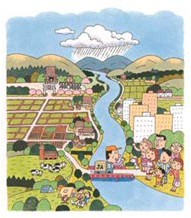Multi-functionality of Agriculture in Japan

<<Source: Fact book 2005>>
The value of multi-functions played by Japanese agriculture particularly in protecting the national land and environment is estimated to be approximately 8.2 trillion yen annually according to the substitutive cost method.
-
 Flood prevention
Flood preventionThe water storage capacity of paddy fields and upland fields during the heavy rainfall season is evaluated in the form of the function played by flood control dams in the country.
-
 Fostering water resources
Fostering water resourcesThe water storage capacity of paddy fields and upland fields during the heavy rainfall season is evaluated in the form of the function played by flood control dams in the country.
-
 Moderating summer heat
Moderating summer heatThe temperature lowering capacity of paddy fields in the summer season is evaluated in the form of the air conditioner costs.
-
 Preventing soil erosion
Preventing soil erosionThe estimated amount of soil erosion prevented by cultivation of farm lands is evaluated in the form of the construction costs of dams for soil erosion prevention in the country.
-
 Recycling the waste into fertilizers
Recycling the waste into fertilizersThe amount of the waste including food leftovers recycled into organic fertilizers is evaluated in the form of the total cost of such waste treatment in the cities.
-
 Preventing landslides
Preventing landslidesThe average amount of damage in the estimated number of landslides prevented by cultivation of farm lands is converted into the estimated value.
-
 Recreational amenities
Recreational amenitiesValues of visits by urban people enjoying rural landscape and recreational amenities are converted into the estimated value.


